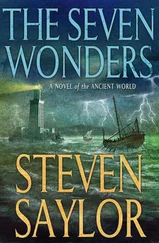The years were sliding by and Stevenson embarked on courses in mathematics and chemistry at Edinburgh University and worked on designs for other lighthouses. All the while, he was untiring in his efforts to interest the board in his now perfected design for a strong stone tower on the Smeaton plan. He envisaged a lighthouse standing over 100 feet tall, 42 feet wide at the base, with 2 feet embedded in the Bell Rock, and the whole exterior of the building encased in granite. The board were polite but cautious. If only ‘it suited my finances to erect 10 feet or 15 feet of such a building before making any call upon the Board for money,’ Stevenson declared with growing impatience, ‘I should be able to convince them that there is not the difficulty which is at first sight imagined’. While the officials procrastinated through 1804, a severe storm blew up and sank the gunship HMS York off the Bell Rock. Sixty-four guns and 491 lives were lost. With the loss of a gunship at a time of Napoleon’s unstoppable progress, the Admiralty at last woke up to the dangers of the Bell Rock.
The board, however, still took no action and somewhat dejected, in December 1805, Stevenson could see no alternative but to send his plans to John Rennie seeking his advice. Rennie was a man at the peak of his career, widely recognised as one of the best civil engineers in the country, with twenty years achievement in building bridges, canals and harbours. None the less, Stevenson felt reluctant to share his ideas after all this time, pointing out that the design had ‘cost me much, very much, trouble and consideration’. Rennie, however, was greatly impressed by his work and replied by return of post. He confirmed that only a stone building would survive the conditions of the Bell Rock and approved Stevenson’s basic plan. He even came to a similar conclusion on the cost of the enterprise.
Rennie’s approval was enough to unlock the door. Overnight, the Northern Lighthouse Board was transformed and unanimous: the commissioners wanted a lighthouse on the Bell Rock such as Rennie advocated. But first there would have to be a Bill passed by Parliament allowing the board to borrow £25,000. In April 1806, John Rennie and Robert Stevenson went in person to Westminster to explain their case to the Lords of the Treasury and the Lords of the Admiralty. Progress was slow, but eventually the Bill was passed and a date set for work to start on the infamous Bell Rock.
The Northern Lighthouse Board, mesmerised by Rennie’s reputation and charmed by his charisma, placed him in overall charge, with Stevenson merely acting as his assistant. Rennie himself, who had never built a lighthouse, argued that the light on Bell Rock should be a fairly faithful copy of Smeaton’s Eddystone Lighthouse, which was, after all, a proven success. He based the design of the lighthouse tower on this concept, but with a much greater curvature at the base to deflect the force of the waves upwards. Although a lot younger, Stevenson considered himself far more knowledgeable about lighthouses than Rennie, having now built several, and he was also familiar with the unique conditions of the Bell Rock. So without ever questioning the older man’s authority, he became quietly determined to work entirely from his own plan.
But no one had ever built a lighthouse where so much of it was underwater. Stevenson could not know for sure whether a stone lighthouse was feasible. There was an awful possibility that the critics were right. Perhaps he was attempting the impossible, endangering life and squandering money. The Bell Rock could so easily have the last word as his imagined sea citadel came tumbling down.
In spite of any misgivings and after the years of delay, Stevenson was anxious to start work on the rock no later than May 1807. His first challenge was how to manage his workforce so far out at sea. No one had ever tried to build a lighthouse on a rock only exposed for two hours in every twelve. As the tide was later by about an hour every day, there would be times when the rock was only uncovered during the night. When building the Eddystone Lighthouse of the Cornish coast, Smeaton had ferried his men to work on a daily basis, but Stevenson did not see that as a practical proposition for the Bell Rock. He decided to take the bold step of keeping his men out at sea, at first on a vessel moored at a safe distance from the rock and, later, in temporary quarters on the rock itself.
Stevenson hoped to raise a sturdy wooden building, the beacon, on the Bell Rock that would stand on timber beams well above the reach of high tide. These temporary barracks would house the men and at night provide a warning light for passing ships. He was only too aware that such a building might be considered precarious, just a few feet above the swirling waters of the North Sea with no land in sight. After all, Captain Brodie’s beacons had not braved the relentless onslaught of the waves for long and Winstanley’s more substantial lighthouse had been blown away in the night like gossamer in the wind, but there was really no alternative. Should a sudden gale blow up, it might be impossible to row back in heavy seas to their vessel, and once the tide turned the exposed rock was all too quickly drowned again by the rush of incoming water. Some kind of temporary dwelling was essential.
Before the beacon could be built, he needed a ship that would fulfil a duel role providing a dormitory for men working on the rock and also a floating light warning ships at sea. The board was obliged to provide a warning light at night while work was in progress, which would enable them to charge dues from passing shipping and start repaying the loan. For this purpose he acquired an 82-ton vessel, the Pharos – named after the first celebrated beacon tower of ancient Egypt, the Pharos of Alexandria. The Pharos was then fitted out to provide 30 bunks for the workmen, quarters for the crew and a cabin for Stevenson that would give him some privacy.
The Pharos would have to be moored one mile from the rock since it was inadvisable to be too near the escarpment should she break anchor in bad weather. Here the water was particularly deep and, as high winds could easily set the ship adrift, a special heavy mushroom-shaped anchor was cast that would dig into the seabed and act as a drag. The men would have to row each day in small boats the mile from the Pharos to their work on the Bell Rock.
The starting date in May passed by and with it went the good weather. Stevenson was becoming impatient, as preparations took longer than anticipated. Another ship had to be built, a 40-ton ship called the Smeaton that would be used to bring out supplies to the rock. Stone from the quarries was ordered and masons were hired to cut each stone into its own individual design so that it interlocked with its neighbour and gave the tower stability. There were tools to be ordered, coal for the smith, food, alcohol, water and then the men to be hired who would labour possibly for years on the rock. Stevenson preferred to hire those who had worked for him before or were recommended. He was a good judge of character and men usually stayed with him on wages of 20 shillings a week, ‘summer or winter, wet or dry’, with rations of 1/ 2pound of beef, 1 pound of bread, 2 ounces of butter and 3 quarts of beer a day. There was, too, the added bonus of papers, which protected them from the press gangs, which were quite ruthless in claiming men for service in the navy.
Stevenson made it quite clear to his men that nights would be spent on board ship and that no man could return home to his family for a month. After a month, he reasoned, the men would have adjusted to seasickness and, hopefully, fear too. He worried that if they were allowed home earlier they probably would not return. He also required the men to work on Sunday. This proved a problem to many, so before they began the epic journey to their new home in the middle of the sea, perhaps as some sort of insurance against the unknown dangers, the men crowded into the little church at the port of Arbroath to hear prayers.
Читать дальше












